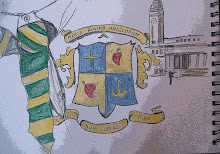The Department of Strategic Clinical Change and Development at NHS Fife have developed an innovative series of electronic clinical pathways, which visualize patient movement within the hospital environment. The idea of this redesign was to get rid of the current system that used clip art to convey these different processes and to create a more appropriate set of pictograms representing different processes within a hospital. The wide range of situations included patient care, GP surgeries and primary care settings to A&E, hospital clinics and theatres.
The pictograms had to demonstrate clarity, certainty, be politically correct, have a strong visual impact and also be acceptable for people with disabilities. As you can see from the image, the set appear to have been designed so that particular pictograms can be linked together. For example all of the pictograms that have a grey background and dotted outline seem to be representing something like administration or office type work. One seems to be the internet, another a filing cabinet and another an email service. Obviously, as these are without text it just goes to show that I can understand this, so the elements of clarity and certainty are definitely within the designs. Then you have the pictograms in blue with a white background. To me, they seem to be representing some sort of procedures such as having an injection and the one in the bottom left with the female symbol I think would represent gynecology. Although I am not quite certain how they are linked, I have a good idea as to what each one means. For the pictograms with the yellow background perhaps they represent different areas in the hospital, particularly because they seem to have the sign showing the hospital on the bottom row.
In terms of the design of the pictograms and the symbols that represent each one, I think consistency has definitely been considered in order to give a strong visual impact like the designers set out to achieve. As you can see where there are people, there is always a break up between the head and the body and the shape of the arms coming off the body in a curved way is always the same too. Where there is negative space in the symbol the colour of the background always comes through, again showing consistency. As for the stroke of the lines you can see that it is more heavily weighted particularly on the symbols with the white background. For example, on the filing cabinet one and the injection one, you can see the outline of these symbols is more heavily weighted than the detail within the symbol. As mentioned before for the use of colour, you can see that the designers have linked certain symbols together through this colour useage, such as having a yellow background or a white background. This is clear to me however, for some of them I am unsure as to why they are linked but perhaps to people working in the hospital this would be very clear.





















































